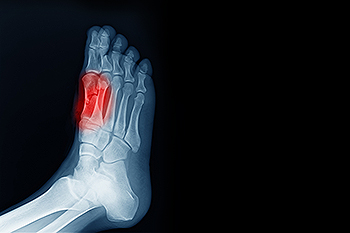
There are bones that are located in the foot which are called the sesamoids. Tendons connect these particular bones to the muscles, and sesamoiditis can happen when these tendons become inflamed. Pain, swelling, and tenderness often accompany this foot condition, and completing daily activities may be difficult to accomplish. The two sesamoid bones are located at the bottom of the foot and big toe, and may also become strained from overuse. People who participate in running and jumping activities may be prone to developing sesamoiditis, and it can be common among dancers. Effective treatment can begin with stopping the activity that caused the injury, and resting the foot as often as possible. Some patients find relief when custom-made orthotics are worn, which may help to provide adequate cushioning. If you have this type of foot pain, please consult with a podiatrist who can properly diagnose and treat sesamoiditis.
Sesamoiditis is an unpleasant foot condition characterized by pain in the balls of the feet. If you think you’re struggling with sesamoiditis, contact the foot specialists of Table Mountain Foot and Ankle. Our doctors will treat your condition thoroughly and effectively.
Sesamoiditis
Sesamoiditis is a condition of the foot that affects the ball of the foot. It is more common in younger people than it is in older people. It can also occur with people who have begun a new exercise program, since their bodies are adjusting to the new physical regimen. Pain may also be caused by the inflammation of tendons surrounding the bones. It is important to seek treatment in its early stages because if you ignore the pain, this condition can lead to more serious problems such as severe irritation and bone fractures.
Causes of Sesamoiditis
- Sudden increase in activity
- Increase in physically strenuous movement without a proper warm up or build up
- Foot structure: those who have smaller, bonier feet or those with a high arch may be more susceptible
Treatment for sesamoiditis is non-invasive and simple. Doctors may recommend a strict rest period where the patient forgoes most physical activity. This will help give the patient time to heal their feet through limited activity. For serious cases, it is best to speak with your doctor to determine a treatment option that will help your specific needs.
If you have any questions please feel free to contact our office located in Wheat Ridge, CO . We offer the newest diagnostic and treatment technologies for all your foot and ankle needs.
